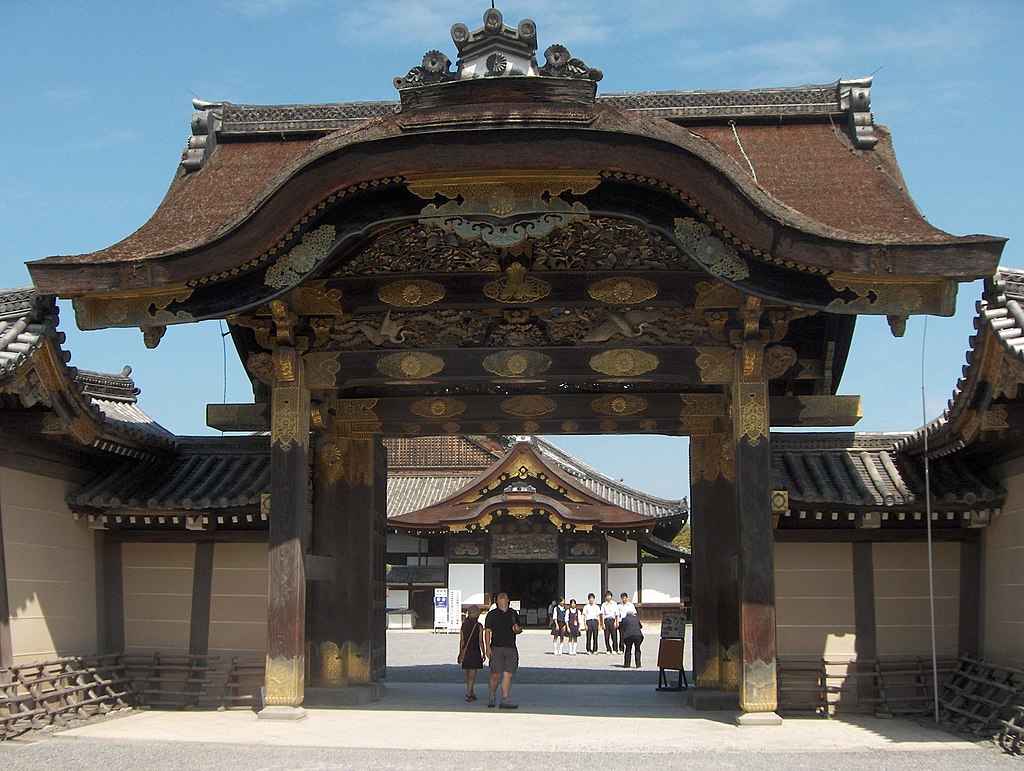As you wander through the serene gardens and magnificent halls of Nijo Castle, the beauty of its art and architecture is impossible to ignore. This historic Japanese landmark, rich in aesthetic appeal and historical significance, offers a fascinating peek into the country’s vibrant cultural heritage.

Table of Contents
Unveiling the Artistic Grandeur
One of the first things that captivate you as you explore Nijo Castle is its stunning Kano School paintings. These intricate artworks, adorning the walls and sliding doors of the castle, perfectly embody the artistic sensibilities of the Edo period.
The themes of these paintings are diverse, often featuring wildlife and scenes from nature, each meticulously depicted to evoke a sense of peace and harmony. The significance of these paintings extends beyond their aesthetic appeal, however. They stand as a testament to the creative excellence that flourished during the Edo period, reflecting a time when art was an integral part of daily life.
Architectural Marvels: The Castle Design
Equally impressive is the architectural design of Nijo Castle. The castle comprises two primary sections: the Ninomaru Palace and the Honmaru Palace. Each of these structures offers its unique glimpse into the architectural trends of the era.
From the sturdy stone walls and extensive moats designed to fortify the castle to the subtle, aesthetic details, every element of the castle’s design is thoughtfully conceived. These features highlight the importance of balance and symmetry in traditional Japanese architecture and the high level of craftsmanship that went into building these historic structures.
A Symphony of Wood: The Nightingale Floors
Another captivating feature of Nijo Castle’s architecture is its unique “Nightingale Floors.” These specially designed wooden floors emit a chirping sound when walked upon, reminiscent of the song of a nightingale bird. This fascinating architectural detail served a dual purpose – adding a musical element to the castle’s ambience and acting as a security measure against intruders.
The Nightingale Floors of Nijo Castle are a testament to the ingenuity and creativity of ancient Japanese architecture, melding function and aesthetics seamlessly.
The Intricacies of Japanese Gardens
No exploration of Nijo Castle is complete without taking the time to admire its traditional Japanese gardens. These landscapes, characterized by meticulously arranged plants, tranquil water features, and carefully placed rocks, provide a serene backdrop to the castle’s grand architecture.
The gardens at Nijo Castle are more than just visually stunning spaces; they are an embodiment of Japanese aesthetics and philosophy. They represent a harmonious blend of natural elements and human creativity, a physical manifestation of the Japanese appreciation for nature’s beauty and its cyclical patterns.
Preservation and Continuity
Over the centuries, efforts to preserve the art and architecture of Nijo Castle have ensured its continuity as a vital link to Japan’s past. These initiatives, ranging from restoration of the Kano School paintings to the upkeep of the Nightingale Floors and gardens, reflect a deep respect for maintaining cultural heritage.
These preservation efforts serve not only to protect the physical aspects of Nijo Castle but also to uphold its historical and cultural value for future generations to appreciate and learn from.
Frequently Asked Questions
When is the best time to visit Nijo Castle?
While the castle is a treat to visit all year round, it is particularly enchanting during the cherry blossom season in spring and the autumn leaves season.
Can you explain more about Kano School paintings?
Kano School was the most famous and influential school of painting in Japanese history. They painted in a variety of styles but are best known for their large scale, brightly colored paintings of birds, animals, and flowers on sliding doors and folding screens in temples, palaces, and daimyo residences.
What makes Nightingale Floors unique?
The Nightingale Floors, or ‘Uguisubari’ in Japanese, were designed to ‘sing’ when stepped on, acting as a natural alarm system against any intruders. The chirping sound is caused by the movement of nails against clamps when pressure is applied to the floorboards.
Are there any specific preservation efforts for the gardens of Nijo Castle?
Yes, the gardens are regularly maintained by skilled gardeners to preserve their original design. This includes careful pruning of trees, maintenance of the pond, and replacement of rocks or elements when necessary.
Immersing yourself in the art and architecture of Nijo Castle offers an intimate look into Japanese history, culture, and aesthetic values. It’s more than a sightseeing spot; it’s an experience that enlightens and enriches. So, the next time you’re in Kyoto, don’t miss the opportunity to discover the wonders of Nijo Castle!
Conclusion
Exploring Nijo Castle offers a profound experience that goes beyond mere sightseeing. It’s a journey through the realms of art, architecture, history, and aesthetics. This iconic Kyoto landmark, with its blend of artistry and architectural genius, continues to inspire and fascinate, serving as a lasting testament to Japan’s rich cultural heritage.
There’s no better way to appreciate the art and architecture of Nijo Castle than by experiencing it firsthand. So, on your next trip to Japan, be sure to add this historic landmark to your must-visit list. And if you’ve already had the chance to explore this architectural wonder, why not share your experiences and impressions? Leave a comment below, or better yet, share this article with others who appreciate the artistry and history that places like Nijo Castle represent. Let’s continue the conversation and celebrate the timeless beauty that these precious cultural treasures offer.
